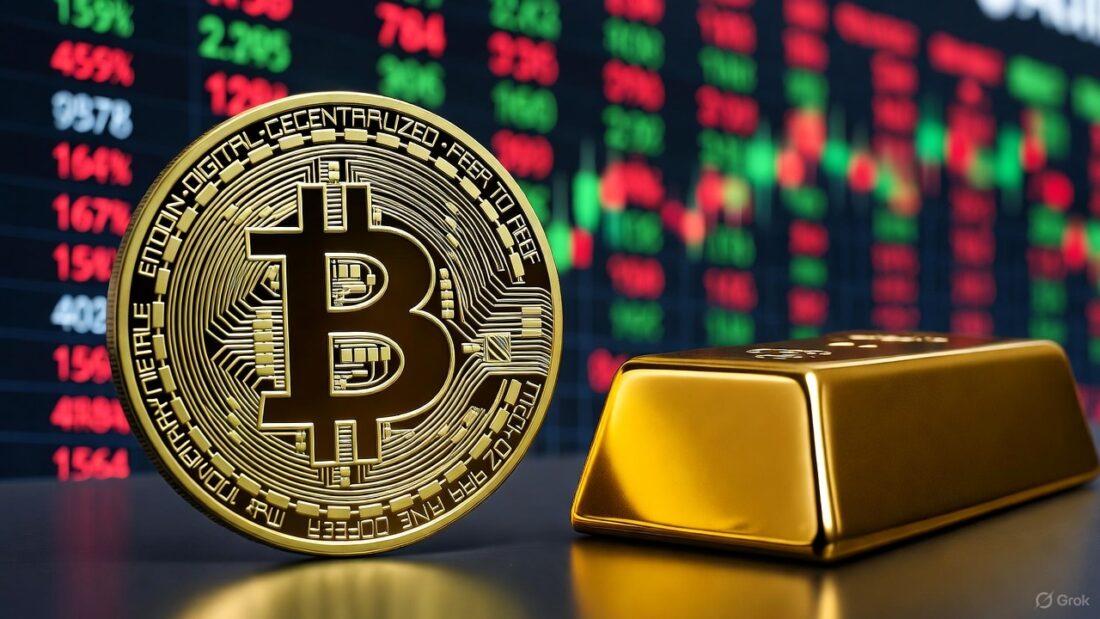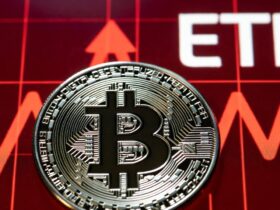For Bitwise, 5% of the gold capital would take the price of bitcoin to more than $240,000.
Bitcoin has a much greater appreciation potential than gold.
In a world where the economy draws uncertain maps, investors are looking for safe havens. Gold, the eternal guardian of wealth, and bitcoin (BTC), the paradigm-defying digital asset, compete for the same capital.
As the precious metal hits all-time highs, a wave of change suggests “digital gold” could be about to claim a significant portion of that financial flow.
Gold has been a relevant protagonist in 2025, with a rise of 58% and a record price of $4,300 per ounce. This rally is due to a confluence of factors: monetary easing by the United States Federal Reserve (FED) and unprecedented structural demand from central banks, especially in emerging markets.


According to Lina Thomas of Goldman Sachs Research, gold purchases on the part of these institutions have quintupled since 2022, after the freezing of Russia’s foreign exchange reserves due to the invasion of Ukraine. “This reflects a structural change in reserve management that will not be reversed soon,” he says.
For its part, bitcoin has shown remarkable performance, with an increase of 63% in its price during the last yearreaching an all-time high of $126,000 in early October 2025, as seen on the chart.


However, a strong correction took it to levels close to $102,000. Despite this volatility, the digital currency maintains a strong narrative as a store of value. A correction in the price of gold, due to a possible overvaluation, could trigger a movement of capital into the digital asset, consolidating its position as an alternative to gold.
The momentum behind bitcoin
Demand through spot exchange-traded funds (ETFs) in the United States has been the main driver of bitcoin’s rise this cycle. These instruments have channeled a massive flow of capital into the digital asset.
The IBIT ETF, managed by BlackRock, the largest on the market, manages 804,944 BTC, equivalent to 3.8% of the total supply that will exist of bitcoin.
This buildup reflects growing confidence in the digital currency as a legitimate investment asset, capable of competing with gold in the minds of institutional investors.
The explosive potential of a capital turnover
Investment firm Bitwise projects a scenario that illustrates the impact of this dynamic. If only 5% of the capital invested in gold were transferred to bitcoin, the price of the digital currency could reach $242,391.
Even a more modest turnover, between 3% and 4%, would double its current value, exceeding $215,000. “Sentiment indicators show an exhaustion of sellers, which limits downside risks and suggests an imminent rebound for bitcoin,” says a report from the firm.
The following graph simulates the price of bitcoin if a percentage of the total value of the gold supply is invested in BTC:


This potential is explained by the asymmetry in the capitalization of both markets. While the gold market exceeds $16 trillion, bitcoin, with more than 50% of the digital asset market capitalization ($2.2 trillion), has much greater room for growth. A small fraction of gold capital could radically transform the price of BTC.
Macro and micro factors driving the shift towards bitcoin
For this capital rotation to occur on a large scale, a combination of specific conditions is required, said Cristóbal Pereira, executive director of Digital Assets Hub Latam, in a conversation with CriptoNoticias.
From a macroeconomic perspective, “a sustained drop in interest rates in the United States, as occurred in 2020, drives demand for alternative assets: that year, after the rate cuts by the FED, bitcoin rose 314%,” Pereira mentioned.
The next FED meeting, on October 29, 2025, could confirm a new rate reduction, as reported by CriptoNoticias. This is an event that both Pereira and Bitwise considered positive for the digital asset, although with some delay in its impact.
In addition, Pereira highlights the importance of resolving global tensions, such as the trade war between the United States and China or the fragility of private credit. “Reduced financial uncertainty would pave the way for investors to see bitcoin as a viable alternative to gold,” he explains.
At the microeconomic level, institutional adoption and a clearer regulatory framework “are obvious catalysts for a migration from gold to bitcoin as a digital store of value,” he says. Initiatives like the GENIUS Act, which seeks to establish precise rules for digital assets, could solidify confidence in bitcoin as a safe haven.
“The volatility of bitcoin, which has decreased from 100% in 2013 to a range of 30%-35% today, is not an obstacle,” says Pereira. “Its programmed scarcity, traceability and autonomy from monetary policies make it increasingly attractive,” he adds.
Gold won’t easily give ground to bitcoin
Despite the enthusiasm for bitcoin, gold maintains structural strength. Goldman Sachs projects that central banks in developing countries will continue to accumulate gold for at least three more years, driven by a diversification strategy in emerging markets.
“These banks have a significantly lower allocation to gold than their peers in developed markets, and they are closing that gap,” explains Thomas.
For his part, Ed Yardeni, president of Yardeni Research, foresees that gold will reach $5,000 per ounce in 2026 and could reach $10,000 between 2028 and 2029. This outlook suggests that the metal will not lose relevance anytime soon, but profit-taking following its rally could open the door for bitcoin.
“Gold responds more to monetary policy and the dollar, while bitcoin is more linked to global growth expectations,” says Bitwise, highlighting the complementary dynamics between both assets.
Bitcoin, the new digital refuge
The narrative of bitcoin as “digital gold” is strengthening in a challenging economic environment. Unlike gold, whose performance depends largely on traditional factors such as monetary policy, bitcoin offers a unique profile: decentralization, planned shortages, and increasing institutional adoptiondriven by vehicles such as ETFs.
Publicly traded companies and governments already consider it a store of value, and its increasing liquidity reduces its historical volatility.
Pereira does not consider Bitwise’s projection of a bitcoin at $240,000 in a three- to five-year horizon to be unreasonable.
“With a capitalization that represents more than half of the digital asset market and rising institutional adoption, the scenario is plausible,” he says. However, he warns that the road will not be without obstacles.. Macroeconomic uncertainty and the need for clear regulatory frameworks will be decisive.
A long-term career
The competition between gold and bitcoin is not a zero-sum game, but the digital currency’s potential to raise capital is undeniable. A correction in the price of gold, combined with a favorable macroeconomic environment and regulatory developments, could accelerate this transition.
While gold remains the traditional safe haven, bitcoin is emerging as a modern alternative, ready to capitalize on any change in investor preferences.
In this scenario, a modest capital rotation out of gold could redefine the digital asset market. With the FED meeting just around the corner, a bitcoin price that has climbed 63% in the last year, and the growing traction of ETFs, the coming months will be crucial in determining whether bitcoin will manage to establish itself as the new “digital gold.”






Leave a Reply